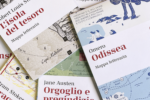56. Biennale – Padiglione filippino
.jpg)
Il progetto Tie A String Around the World rappresenta le Filippine alla 56. Biennale di Venezia.
Comunicato stampa
In 1950 in the Philippines, the filmmaker Manuel Conde and the painter Carlos Francisco worked together to do the first film ever on Genghis Khan. Telling the tale of the conqueror's rite of passage from warrior to overlord in the form of a metrical romance and an adventure, it bemused both Hollywood and Venice. The Philippine Pavilion returns to Venice after 51 years through this exemplary film to reflect on the country's modernity and the present scheme of a world redrawn on the surface of water. Around this premise, Jose Tence Ruiz intimates the specter of the Philippine ship on the South China Sea, at once "slum fortress" and armature of archipelago. Manny Montelibano refunctions the sound and image of a threshold of territory to scan both the epic of survival and the radio frequency of incursion. Surveying his dominion at the end of the seminal film, Genghis Khan professes to his beloved that he would tie a string around the world and lay it at her feet, a gesture of intense affection, of breathtaking hubris.
As the Philippines renews its participation in Venice in 2015, so is the film revisited as a trajectory into the very idea of Venice as the place that has recognized the country some 60 years ago through the moving image. Translated in 16 languages, Genghis Khan was re-edited and narrated by the writer-critic James Agee and screened at the Museum of Modern Art and the Venice Film Festival in 1952, where it competed with the films of Chaplin, Clement, Fellini, Bergman, and Mizoguchi. This travel indexes an aspiration; at the same time, it offers an opportunity to reflect on the state of the world today and the potential of a Philippine Pavilion in Venice to initiate a conversation on its changing configurations via the Philippines.
The film Genghis Khan is the pivot of the Pavilion, the node at which two contemporary projects are coordinated to imagine the condition of the world and the modes of its conquest as referenced by the storied life of Genghis Khan through the idiosyncratic Philippine film. The Pavilion risks an interpretation of an archipelagic world in relation to the cinema and the sea. The "Philippine," an archipelago and simultaneously a figurine of the Spanish King Philip, serves as a theoretical mode and method.
The history of the world, therefore, is a history of modernity and, more specifically, a history of the modernity of art and its attendant labor and facture: Tence Ruiz clads the ship relentlessly and with obsession, while Montelibano builds up the layers of sound with the same acuity. Their forebears Conde and Francisco, both National Artists of the country, conceived of Genghis Khan in the vein of a modernity at once worldly and committed to an ebullient locality, suffering no neurosis of the outside and not belaboring the authentic that is supposedly immanent.
The Philippine Pavilion casts its lot with the prospects of the world being strung like islands in an archipelago, with water around it, replenishing or flooding it, ferrying its people across or forcing them to be where they are. But this shifting, sedimented site that is the Philippines is built as strata of the elements, very much how Venice, in the vision of the historian Fernand Braudel, "rises over an engulfed forest," an overlay of water, land, country, shoal, epic, reef, country, vessel—and all the strings around the world.
The Philippine Pavilion is commissioned by the National Commission for Culture and the Arts, with the support of the Department of Foreign Affairs and the Office of Senator Loren Legarda. It is curated by Patrick D. Flores. In August 2015, David Medalla will lecture and perform at the Pavilion.



